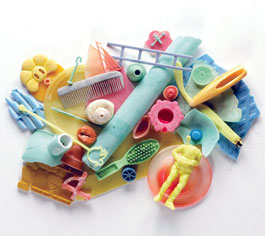home | north bay bohemian index | the arts | visual arts | review

'YELLOW MAN': Found beach plastic is used in assemblage by artists Judith and Richard Lang.
Plastic Perfection
Marin artists 'curate' the beach of trash
By Gretchen Giles
Judith Selby Lang's 60th birthday began with an ordinary routine. She and her husband Richard Lang went to the beach and picked up trash. But make no mistake, the Langs—artists and co-owners of San Francisco's Electric Works Gallery and fine art publishing house—are not merely trawling for any old garbage. They're looking for plastic.
And, boy, do they find it. Since 1999, when they began religiously walking the half-mile stretch of Kehoe Beach in the Pt. Reyes National Seashore, a short drive from their West Marin home, the two estimate that they have gathered literally tons of the stuff—one barrette, disposal lighter or Happy Meal toy at a time.
"The estimate is around 70 pounds every trip," Richard says. "We don't want to overestimate, because hyperbole really gets you in trouble and then nobody believes you. The small end of the spectrum: it's at least two tons of plastic that we've picked up, and probably four—maybe five."
The Langs call what they do "shopping" or "curating the beach," as the plastic doll parts, oyster netting and ubiquitous Bics are taken home, washed of sand and sorted—by color. Accordingly, their airy basement studio is lined with cardboard boxes labeled "big black" and "small green."
"When we're composing, these pieces of plastic are not what they once were," Richard explains. "It doesn't matter what they were. They are there for color and shape, and very much like a piece of paint lifted from a palette and put on a canvas."
The pair collaborate on poetic assemblage, photographing the resulting work. Sausalito's Cavallo Point recently commissioned a work for every guest room in its lodge and is exhibiting the Lang's art in the resort's in-house gallery.
Because their art materials consist almost solely of found beach plastic, the Langs have become unwilling pollution experts. They have detritus from the North Pacific gyre dumped down by their barn, huge "ghost" nets and other plasticine rope in a tangle, but most of the plastic in the world's five gyres isn't tensile at all. "We describe it more like a minestrone," Judith says. "It's more like this stew of stuff all mixed up, and you really can't see it. That's where the deniers say, 'Oh, if you can't see it, it doesn't exist.' But where they have taken samples, it's just tubes of this sloshy, swirly kind of mix of stuff."
The couple say that increasing public awareness of plastic pollution and the state of the oceans gives them hope. And mostly they just keep doing what they do because they would never want not to.
"I think the really crucial element of the story is what happens when you focus your attention on one thing and just keep doing it," Richard says. "We had no idea this would turn into artwork. We had no idea we would actually make part of our living doing this. It's a fantastic story of what happens when you do the same thing again and again."
'From Kehoe to Cavallo: The Mystery in the Mess' shows at Cavallo Point through Oct. 22. A free public reception is slated for Thursday, July 22, from 5pm to 7pm. 601 Murray Circle, Ft. Baker, Sausalito. 415.339.4700. To learn more about the Lang's work, listen to 'Arts I.D.' on KRCB 91.1-FM on Wednesday, July 28, at 7pm.
Send a letter to the editor about this story.
|
|
|
|
|
|